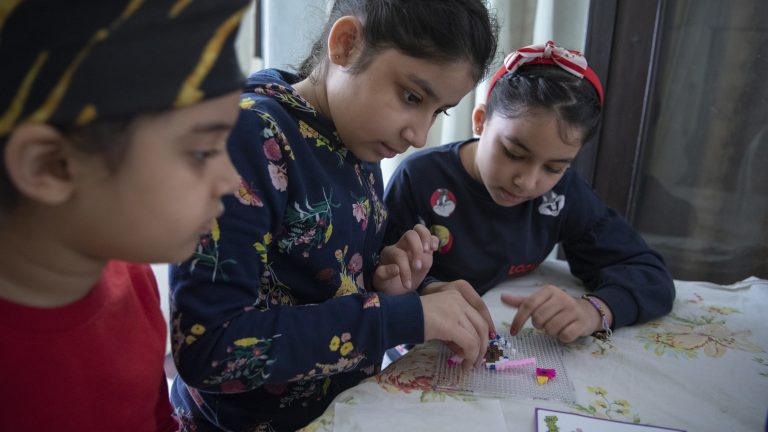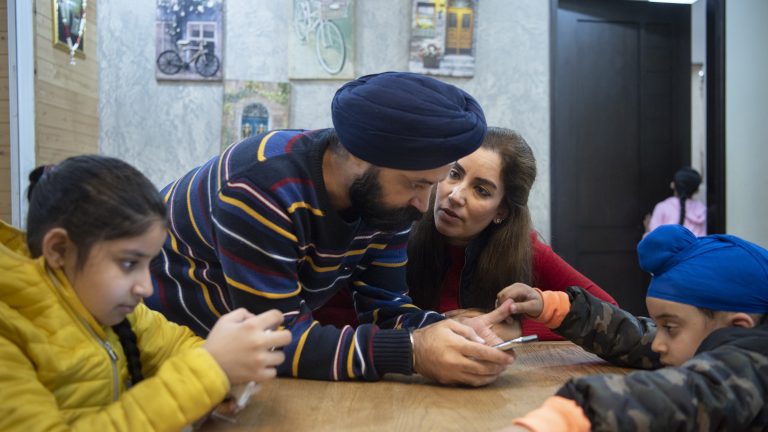It’s early in the morning and the Singh family piles into their SUV with pillows, blankets, toys, and snacks. The Singhs — mother and father Ramneek and Puneet, and their three preteen kids, Anaanya, Shanaya, and Siaan — have signed up for the “24 hours living in the car” challenge, and none of them can now leave the vehicle, not even for a loo break, for the next 24 hours.
They spend the day driving around Delhi, vlogging the whole way. As night falls, they park, put their seats back, and go to sleep. Until 3:30 a.m., when 6-year-old Siaan starts nagging to go to the toilet. They give up, a few hours short of their target. More than 3.4 million people watch them fail the challenge.
The Singhs are one of India’s most-followed social media influencer families. With six YouTube channels, five individual Instagram accounts, three Facebook pages, and two accounts on MX TakaTak, they have a total social media following of over 18 million. Their YouTube videos — which offer a peek into their day-to-day life, almost like Keeping Up with the Kardashians on a budget — have been watched over 8 billion times. Each week, the family produces 75 Reels and 35 video posts for Instagram, and 35 Shorts and 20 full-length videos for YouTube, featuring everything from short films and vlogs to dance videos. They have promotional deals with major brands and entertainment studios, even their own merchandise line.
The Singhs are at the forefront of an emerging trend on the Indian internet: family influencers. What started on TikTok, which is now banned in India, has moved to Instagram and YouTube, where relatives — brothers and sisters, mothers and daughters, and grandmothers and grandsons — are making content together. But behind the happy faces on social media, the reality of content creation involving families, and particularly children, can be complex and fraught with risk.
“When parents are the producers, the whole act is synonymous to sending your kid to school and saying, ‘score at least 80% or above,” Shriram Venkatraman, a digital anthropologist who has studied social media families, told Rest of World. “Now, on social media, these kids have to perform every evening. This is like sitting [for] an exam every day.”

Ramneek Singh was introduced to TikTok by a relative in January 2019. Ramneek, who had been running his family’s car dealership for around 20 years, was quickly hooked.
“I tried [TikTok] for the fun of a new app,” Ramneek told Rest of World, sitting on a recliner chair at his home in New Delhi during an interview in early December. After his initial videos went viral, he said it just became his hobby.
While the kids featured in Ramneek’s videos since the beginning, Puneet was less impressed. “We fought over this a lot of times,” she recalled. “I told him why are you wasting our time like this?” Eventually, Ramneek convinced her to feature in a video where they created a domino of 500 iPhones. “I appeared on camera to shut him up,” Puneet said. But the next day, when her phone was flooded with a flurry of texts from friends, relatives, and neighbors asking if it was her in the video, there was no going back. She realized that the family was sitting on a fortune. “I realized that it really matters. I thought it was fun — let’s do it,” she said.
As their follower numbers grew, the family started getting approached by sponsors and marketers. To maximize their earnings, they opened individual social media accounts for each of the family members. The kids own separate phones, however, Ramneek said they use them only for their schoolwork or playing games, and he runs their social media accounts.
Today, they earn a “good, six-figure” income in Indian rupees every month from promotions, merchandising, and contracts. They have exclusive content production contracts with YouTube Shorts and MX TakaTak. In November 2021 alone, the family did more than a dozen brand promotions, including for kids TV channels Discovery Kids and Nickelodeon, online education portals Byju’s and Unacademy, and consumer brands. Ramneek has quit his business and spends his entire time managing the social media influencers in the house.

These days, the Singhs’ world revolves around cameras. Everything is content. (The family wanted to vlog the interview when this reporter visited their home. The request was politely declined.) The family has hired a video editor, a scriptwriter, and an assistant for Ramneek.
The family is so popular that the kids often get recognized by fans at malls, and their classmates keep sending fan texts during online school. The family has received requests for selfies and autographs while sitting in their car at traffic signals. During a holiday, they were followed by a couple for more than 300 kilometers, from Mussoorie to Amritsar, to get a photograph for their child.
“Other families are very boring, they are always bored,” Anaanya said, “but we have something to do; we can make videos all day long.”
Onscreen, the Singhs appear as a perfect, happy family. Puneet and Ramneek think that this is the key to their popularity, and that it’s made them fight less in private. Puneet said that the couple used to argue more, but now she tends to let things lie. “I cannot fight; I have to give my time productively here,” she said. “If I’m angry somewhere in the back of my mind, I cannot be happy on camera.” If anyone in the family fights, Ramneek said he tells them to “hold on for two more hours — just don’t fight in front of the camera. Even if you kill each other later, that’s fine.”
But turning your home into your studio creates unique stresses. Ramneek typically starts looking at traffic analytics for a video about 30 minutes after posting it. The graphs dictate the rest of the day. “When videos do not work, it makes us sad,” said Puneet. “[Ramneek’s] mood gets bad, very bad.” On those nights, Ramneek prefers to be left alone.

On the day Rest of World visited the family, Ramneek and Shanaya were trying to create a perfect video of acting to a Punjabi song. Anaanya, who was shooting the video, maneuvered an iPhone carefully to get the perfect shot. Shanaya smiled as the camera recorded, but the shot wasn’t perfect. They tried again. And again. And again. In between, dresses had to be changed. A few takes later, the smile wore off.
“When spending time with the children becomes the job, the family fails to create memories that go beyond ‘content,’ and the children grow up to feel more alienated.”
Rashi Laskari, a psychologist and family therapist who has counseled several content-creator parents and families, believes putting on a show for the camera can have serious consequences in the long haul. “The unresolved conflicts rise when the social media algorithm takes priority and it is a very unhealthy pattern that leads to passive-aggressive behavior,” Laskari said. If every interaction between parents and children is recorded for an audience, a family’s relationship can fracture.
“When spending time with the children becomes the job, the family fails to create memories that go beyond ‘content,’ and the children grow up to feel more alienated,” Laskari said.
During his research, Venkatraman found that a lot of teens were unhappy with their childhood on the internet. “They say that ‘my parents made me do it’ and it has led to serious body image issues in some,” he said. “These children are hyper-visible and with issues like ‘cancel culture,’ there is going to be a lot of burden on these kids, who might not have wanted this life.”
Some Western countries have come up with a legal framework to tackle the largely unregulated work of kidfluencers and subsequent easy exploitation by the parents. In October 2020, France even included the Right to be Forgotten — requiring social media platforms to remove a child’s videos upon requests, overruling parents. But India doesn’t have such rules.
Ramneek has seen the ugly side of the industry when one of Anaanya’s dancing videos on YouTube was flooded with hateful and pedophilic comments. To protect the kids, Ramneek said, he hasn’t given social media access to them and is waiting for them to be of appropriate age.
Of the children, only Anaanya remembers not being an influencer. She recalls the time before as the “boring life of any other kid.” Her parents expect she, and the others, will want to stay in the family business. “They have a lot of fame in this. Popularity drives them. Why won’t they want it?” Puneet said as everyone shared a unanimous, awkward laugh.





